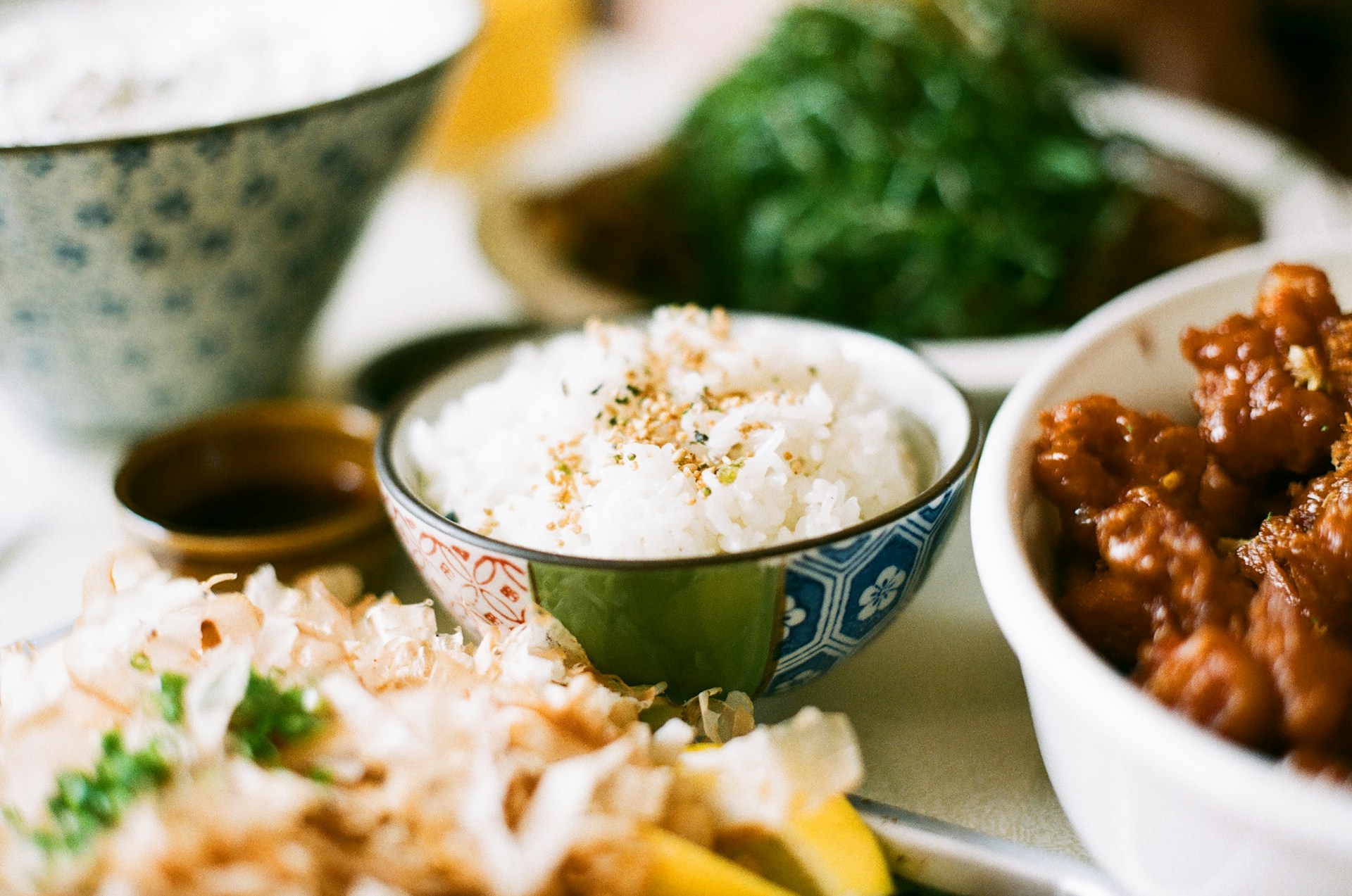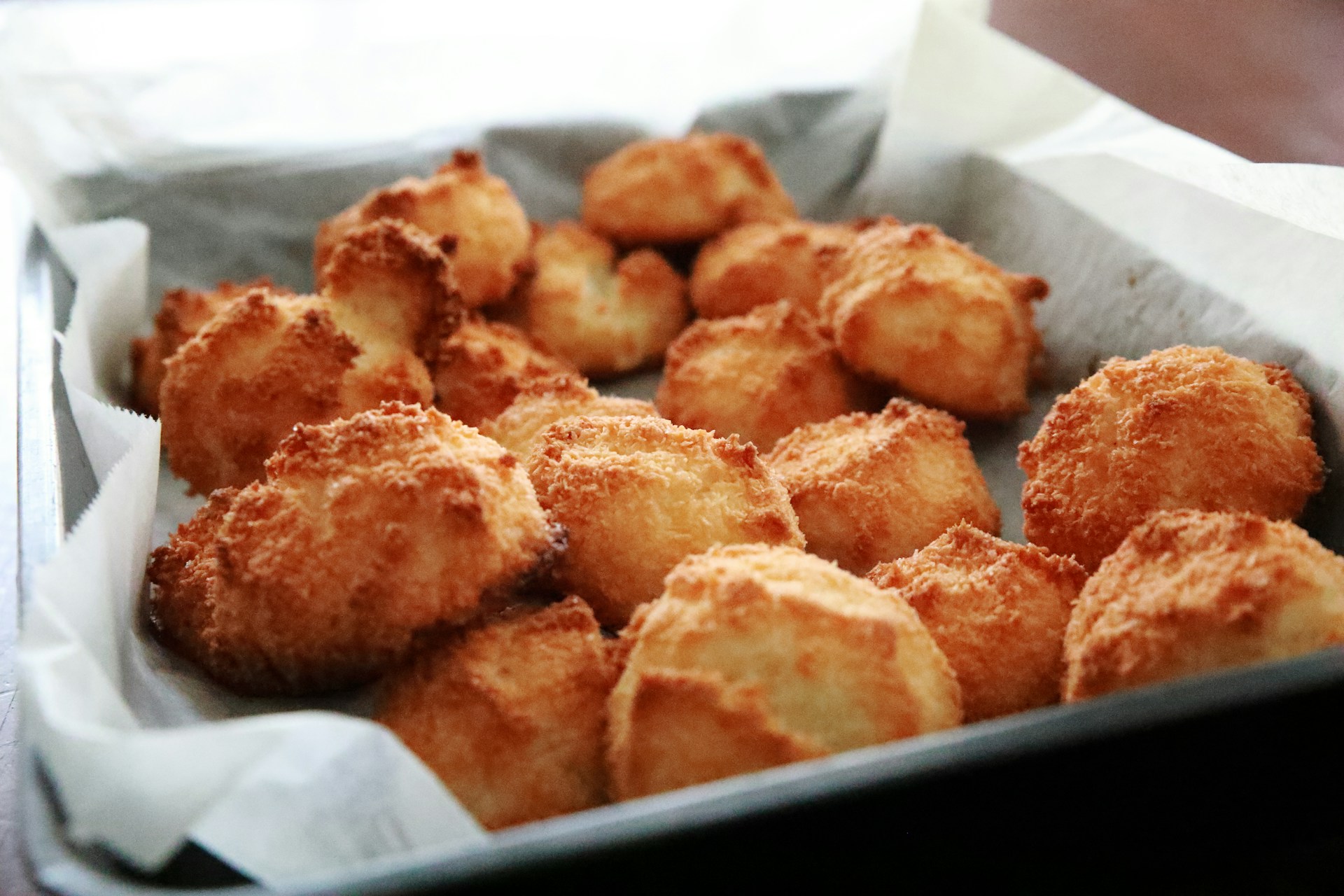The Effect of Rice Cooking Techniques on the Sensory Evaluation Test and Fluffiness Levels of Analog Rice Made from Sorghum, Mocaf, Glucomannan, and Moringa Flour
Pengaruh Teknik Penanakan Beras terhadap Evaluasi Sensori dan Tingkat Kepulenan Nasi dari Beras Analog Berbahan Baku Tepung Sorgum, Mocaf, Glukomanan, dan Kelor

Downloads
Background: Rice cooking is the process of rice making with several cooking stages and types such as using rice cookers and steamers. This analog rice innovation aims to increase the nutritional value, food diversification, and functional foods.
Objectives: To determine the effect of rice cooking techniques on sensory tests (color, texture, aroma, and overall appearance) and fluffiness levels between analog rice and C4 rice.
Methods: This experimental research used a Completely Randomized Design (CRD) on analog rice resulting from the best treatment (P2) with an additional composition of 2 gram of Moringa flour. The cooking techniques used rice cookers and steamers for cooking both analog rice and C4 rice. A total of 25 semi-trained panelists were selected to identify sensory evaluation and the fluffiness levels of the product. The statistical analysis used the Mann-Whitney test with the help of SPSS version 23.0.
Results: Cooking techniques using a rice cooker and a steamer influenced the sensory evaluation tests (color (p=0.004), texture (p=0.002), and overall appearance (p=0.006)) and fluffiness levels (p=0.004) for analog rice. However, cooking techniques did not influence the sensory evaluation test for taste (p=0.396) and aroma (p=0.058). The sensory tests such as color (p=0.607), texture (p=0.578), overall appearance (p=0.701), taste (p=0.482) and aroma (p=0.216) and the level of fluffiness in C4 rice (p=0.891) did not show differences.
Conclusions: The steaming cooking technique influences the preference and fluffiness levels of analog rice. Cooking analog rice with the steaming technique is highly recommended in order to increase consumer preference.
Clemente-Suárez, V. J. et al. New Insights and Potential Therapeutic Interventions in Metabolic Diseases. Int J Mol Sci 24, 10672 (2023).
Saftarina, F., Angraini, D. I. & Mayasari, D. Determinants of type 2 diabetes mellitus in agricultural community. Jurnal Gizi dan Dietetik Indonesia (Indonesian Journal of Nutrition and Dietetics) 11, 40–46 (2023).
Fathurrahman, T., Imanuddin, I., Atoy, L. & Jelina, A. Perspektif Lokalitas Bahan Pangan Alternatif bagi Masyarakat: Studi Eksperimental Pemberian Cucur Beras Merah terhadap Penderita Diabetes Melitus Tipe 2. JIIP - Jurnal Ilmiah Ilmu Pendidikan 5, 67–72 (2022).
Jannah, M. et al. Pembuatan Dan Uji Karakteristik Fisik Beras Analog Berbahan Baku Tepung Singkong Yang Diperkaya Dengan Protein Udang the Production and Physical Characteristics Test of Analog Rice Made From Cassava Flour Containing Protein of Shrimp. Jurnal Teknik Pertanian LampungVol 4, 51–56 (2015).
Adelina, F., Estiasih, T. & Widyaningsih, T. D. Beras Tiruan Berbasis Ubi Kayu : Studi Kepusrakaan Cassava Based Artificial Rice : A Review. Jurnal Teknologi Pertanian 20, 11–24 (2019).
Widiyono, W., Rachmat, A., Nugroho, S., Lestari, P. & Syarif, F. Physiological characteristic of 10 sorghums genotypes under water stress in greenhouse. IOP Conference Series: Earth and Environmental Science 762, (2021).
Tanwar, R., Panghal, A., Chaudhary, G., Kumari, A. & Chhikara, N. Nutritional, phytochemical and functional potential of sorghum: A review. Food Chemistry Advances 3, 100501 (2023).
Adebo, O. A. African Sorghum-Based Fermented Foods: Past, Current and Future Prospects. Nutrients 12, 1111 (2020).
Bendri, P. D. Pengaruh Komposisi Tepung Mocaf Dan Labu Kuning Terhadap Karakteristik Nugget Mocaf Labu Kuning. Journal of Nutrition Science 8, 55 (2019).
Priadi, G., Setiyoningrum, F., Afiati, F. & Syarief, R. Pemanfaatan modified cassava flour dan tepung tapioka sebagai bahan pengisi keju cedar olahan. Jurnal Litbang Industri 8, 61 (2018).
Rahayu, S. & Hasibuan, R. Pemanfaatan Tanaman Kelor (Moringa oleifera) sebagai Obat Tradisional di Dusun Aek Kulim Mandalasena Kabupaten Labuhanbatu Selatan. Jurnal Ilmiah Biologi 11, 386–393 (2023).
Saputri, R. et al. Pengaruh pemberian jelly mengandung glukomanan porang (Amorphophalus oncophyllus) dan inulin sebagai makanan selingan terhadap berat badan, IMT, lemak tubuh, kadar kolesterol total, dan trigliserida pada orang dewasa obesitas. Jurnal Gizi Klinik Indonesia 17, 166 (2021).
Risti, D., Aprilia, V. & Nisa, F. Z. Sifat fisik, kadar serat, dan daya terima naget dengan penggunaan glukomanan dari porang (Amorphophallus oncophyllus) untuk substitusi daging ayam. Jurnal Gizi dan Dietetik Indonesia (Indonesian Journal of Nutrition and Dietetics) 5, 9 (2018).
Siska Ariftiyana et al. Porang (Amorphophallus oncophyllus) Flour Macerated with Strobilanthes crispus Reduced the Blood Glucose Levels of Streptozotocin-Induced Diabetic Rats | Open Access Macedonian Journal of Medical Sciences. 10, 127–131 (2022).
Dina Seftina, Arif Sabta Aji, Veriani Aprilia, & Satrijo Saloko. Analis Proksimat (Kadar Air, Kadar Abu,Protein, Lemak dan Karbohidrat) dan Aktivitas Antioksidan Beras Analog Berbasis Pangan Lokal Sebagai Alternatif Pangan Fungsional Penderrita Diabetes Mellitus. (Universitas Alma Ata, 2022).
Ika Wahyuningsih, Arif Sabta Aji, Veriani Aprilia, & Effatul Afifah. Analisis Serat Pangan Dan Uji Organoleptik Beras Analog Berbasis Pangan Lokal Sebagai Alternatif Pangan Fungsional Penderita Diabetes Melitus. (Universitas Alma Ata, 2022).
Intan, N. F. Analisis Kebutuhan Air Untuk Penanakan Nasi Dengan Berbagai Jenis Beras. (Universitas Lampung, 2018).
Maria, M. & Nugraheni, A. Uji Hedonik Teh Gaharu Gyrinops versteegii dengan Berbagai Metode Pengolahan Daun. Jurnal Riset Industri Hasil Hutan 13, 99–110 (2021).
Wahyuningsih, I. et al. Sensory Evaluation and Fiber Content Analysis of Analog Rice With Moringa Leaf Flour Substitution. Indonesian Journal of Human Nutrition 6, 28–41 (2023).
Zakiatul, A. & Ismawati, R. Studi Tentang Tingkat Kesukaan Responden Terhadap Penganekaragaman Lauk Pauk dari Daun Kelor (Moringa oleivera ). 5, 17–22 (2016).
Indrasti, D., Nuri Andarwulan, Purnomo, E. H. & Nur Wulandari. Suji Leaf Chlorophyll: Potential and Challenges as Natural Colorant. Jurnal Ilmu Pertanian Indonesia 24, 109–116 (2019).
Putri Hani Sundari, 143020155, Nana Sutisna Achyadi, D. & Neneng Suliasih, D. S. Pengaruh Perbandingan Mocaf (Modifed Cassava Flour) Dengan Tepung Terigu Dan Penambahan Tepung Daun Kelor (Moringa oleifera) Terhadap Karakteristik Pasta Kering Makaroni. (Fakultas Teknik Unpas, 2019).
Augustyn, G. H., Tuhumury, H. C. D. & Dahoklory, M. Pengaruh Penambahan Tepung Daun Kelor (Moringa oleifera) Terhadap Karakteristik Organoleptik Dan Kimia Biskuit Mocaf (Modified Cassava Flour). AGRITEKNO: Jurnal Teknologi Pertanian 6, 52–58 (2017).
Indriyani, Y., Luthfi, L. & Azis, Y. Preferensi Konsumen terhadap Beras Pulen dan Beras Pera di Pasar Bauntung Kota Banjarbaru. Frontier Agribisnis 4, (2020).
Septianingrum, E. & Kusbiantoro, B. Review Indeks Glikemik Beras : Faktor-Faktor yang Mempengaruhi dan Keterkaitannya terhadap Kesehatan Tubuh. Jurnal Kesehatan 1, 1–9 (2016).
Letiora, J. A. S., Sineke, J. & Purba, R. B. Bubuk Daun Kelor Sebagai Formula Makanan Balita Stunting. Jurnal GIZIDO 12, 105–112 (2020).
Komalasari, H., Saloko, S. & Sulastri, Y. Pengaruh Penggunaan Daun Kelor Dan Penambahan Sargassum sp. Terhadap Sifat Fisikokimia Dan Sensoris Beras Analog. (2018).
Hasibuan, E., Hamzah, F. & Rahmayuni, D. Sifat Kimia Dan Organoleptik Pati Sagu (Metroxylon sago Rottb.) Modifikasi Kimia Dengan Perlakuan Sodium Tripolyphosphate (STPP). Jom Faperta 3, (2016).
Picauly, P. & Tetelepta, G. Uji Organoleptik Crackers Pisang Tongka Langit. AGRITEKNO: Jurnal Teknologi Pertanian 5, 53–57 (2016).
Candra Safira, D. Pengaruh Waktu Pemasakan Dan Konsentrasi Santan Kelapa Terhadap Karakteristik Nasi Kuning Instan Varietas IR 64. (Universitas Pasundan Bandung, 2019).
Copyright (c) 2024 Amerta Nutrition

This work is licensed under a Creative Commons Attribution-ShareAlike 4.0 International License.
AMERTA NUTR by Unair is licensed under a Creative Commons Attribution-ShareAlike 4.0 International License.
1. The journal allows the author to hold the copyright of the article without restrictions.
2. The journal allows the author(s) to retain publishing rights without restrictions
3. The legal formal aspect of journal publication accessibility refers to Creative Commons Attribution Share-Alike (CC BY-SA).
4. The Creative Commons Attribution Share-Alike (CC BY-SA) license allows re-distribution and re-use of a licensed work on the conditions that the creator is appropriately credited and that any derivative work is made available under "the same, similar or a compatible license”. Other than the conditions mentioned above, the editorial board is not responsible for copyright violation.
















































